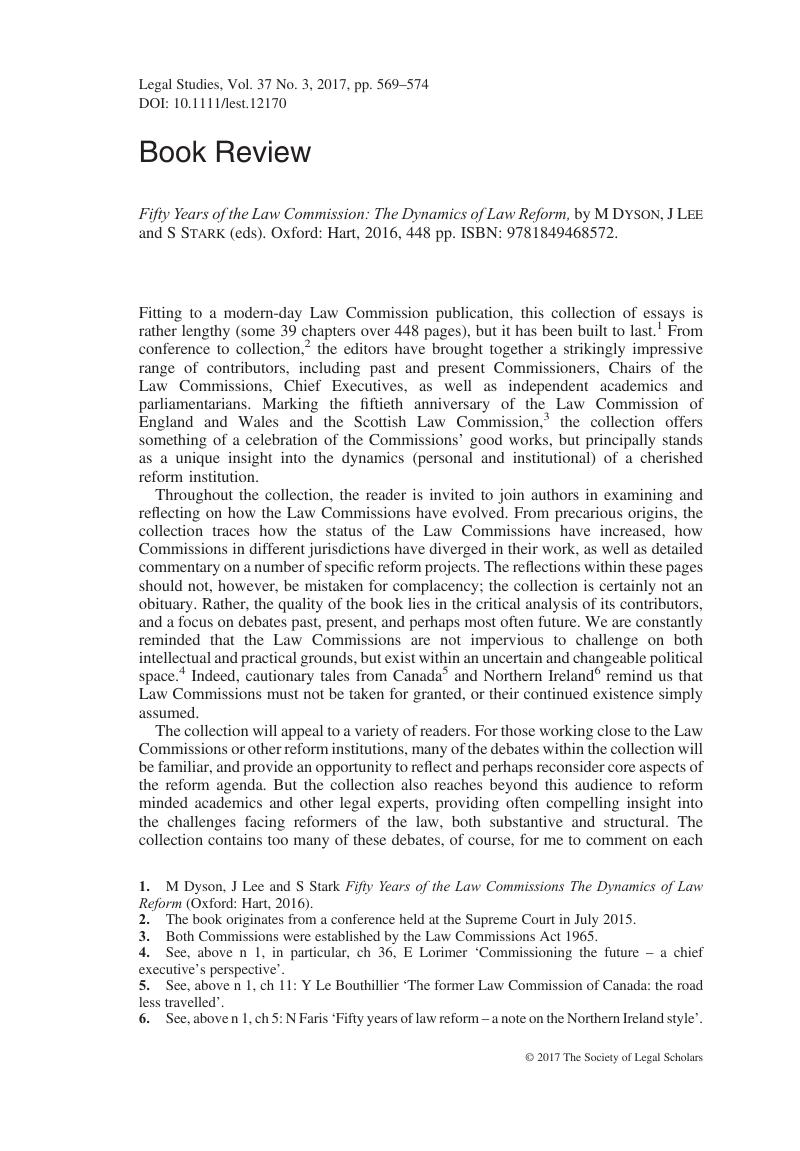No CrossRef data available.
Published online by Cambridge University Press: 02 January 2018

1. M Dyson, J Lee and S Stark Fifty Years of the Law Commissions The Dynamics of Law Reform (Oxford: Hart, 2016).
2. The book originates from a conference held at the Supreme Court in July 2015.
3. Both Commissions were established by the Law Commissions Act 1965.
4. See, above n 1, in particular, ch 36, E Lorimer ‘Commissioning the future – a chief executive's perspective’.
5. See, above n 1, ch 11: Y Le Bouthillier ‘The former Law Commission of Canada: the road less travelled’.
6. See, above n 1, ch 5: N Faris ‘Fifty years of law reform – a note on the Northern Ireland style’.
7. See, above n 1, chs 1, 15, 29 and 38: M Dyson et al ‘Introduction’; S Stark ‘Promoting law reform: by means of draft bills or otherwise’; J Lee ‘The etiquette of law reform’; M Dyson ‘The future is a foreign country, they do things differently there’.
8. The Law Commissions Act 1965, s3 (emphasis added).
9. On the early years of the Law Commission for England and Wales, see n 1. chs 2, 3 and 4: Lady Hale ‘Fifty years of the Law Commissions: the dynamics of law reform now, then and next’; Lord Hodge ‘Introduction’; P Mitchell ‘Strategies of the early Law Commission’. On the Scottish Law Commission, see n 1, chs 17 and 34: L Dunlop ‘A good name, a long game’; Lord Pentland ‘The Scottish Law Commission and the future of law reform in Scotland’.
10. For example, see discussion above in n 1 chs 35 and 7: DL Jones ‘Looking to the future’; E Clive ‘Law reform and social policy’.
11. For example, see discussion above in n 1, ch 10: G Gretton ‘The duty to make the law more accessible? The two c‐words’. See also G Palmer ‘The law reform enterprise: evaluating the past and charting the future’ (2015) 131 LQR 402.
12. For example, see discussion above in n 11 above: Gretton; n 9 above, Lord Pentland,
13. For example, see discussion above in n 1, chs 12, 21, 32 and 35: I Dennis ‘The Law Commission and the criminal law: reflections on the codification project’; N Paines ‘Reflections on statutory implementation in the Law Commission’; D Ormerod ‘Reflections on the courts and the Commission’; n 10 above, Jones.
14. Above n 1, ch 39: KJ Keith ‘Making law – who, how and what?’
15. Above n 1, chs 6 and 30: K Cronin ‘Working on the larger canvas – law reform in a federal system: thoughts on forty years of the Australian Law Reform Commission’; B McDonald ‘Law reform in private law: the role of statutes in supplementing or supplanting the common law’.
16. Above n 1, discussed in ch 18: M Arden ‘Introduction’.
17. See above n 5.
18. See above n 7, Dyson.
19. See, for example, above n 13, Dennis and Ormerod.
20. The detailed breakdown of figures in this chapter is extremely enlightening, although, as the author highlights, should be treated with some critical care: G Hammond ‘The legislative implementation of law reform proposals’.
21. These changes are discussed in several chapters. See, in particular n 10 above Mitchell; above n 1 ch 9 Etherton ‘Memoir of a reforming chairman’; n 10 above, Jones.
22. See, in particular, above n 21, Etherton; above n 20, Hammond; above n1, ch 22 H MacQueen ‘Implementation by statute: what the future holds’; above n 1, ch 26, J Beatson ‘Challenges for independent law reformers from changing external priorities and shorter timescales’; above n 1, ch 27, S Lewis ‘The bill's progress’.
23. On the importance of independence, see above n 5, and above n 6; above n 4.
24. See, for example, discussion above n 20, Etherton.
25. See discussion above n 11, Gretton; and above n 1, ch 16, W Binchy ‘Law Commissions, courts and society: a sceptical view’.
26. See discussion in above n 1, chs 2, 19 and 36: above n 9, Hale; above n 20, Hammond; above n 4, Lorimer.
27. See also Horder, Homicide and the Politics of Law Reform (Oxford: Oxford University Press, 2012).
28. See above n 1, ch 17, and chapters within Part 7. Above n 9, Dunlop.
29. See discussion above n 13, Ormerod.
30. See above n 1, ch 15 in particular: SW Stark ‘Promoting law reform: by means of draft bills or otherwise’. For a useful discussion about quantifying the Law Commissions' influence on the judiciary, see above n 7, Lee.
31. See discussion above n1, ch 14, Lord Toulson ‘Democracy, law reform and the rule of law’; above n 15 McDonald; above n 13, Ormerod; above n1, ch 37, M McMillan ‘Implementation of law reform reports: developments in Scotland’.
32. Above n 1, A Burrows ‘Post‐legislative scrutiny, legislative drafting and the “elusive boundary”’. Discussed further above n 13, Ormerod.
33. See above n 1, ch 33: E Cooke ‘Introduction’; above n 9, Pentland.
34. On social issues, see above n 9; Pentland. On legal reasoning, see above n 5, and above n 7, Dyson. On procedure and evidence, see above n 7, Dyson, and above n 13, Dennis. On reviewing delegated legislation, see above n 15, Cronin.
35. Above n 1, H Beale ‘The law commission method: exportable to the EU?’
36. Along with Dr Jonathan Rogers, I have begun an initiative to engage more academics and other legal experts with a reform agenda, under the banner ‘Criminal Law Reform Now’ (www.clrnn.co.uk).
37. See, for example, above n 9; above n 35; above n 7, Dyson.
38. See the Scottish Law Commission website, https://www.scotlawcom.gov.uk/news/landmark‐agreement‐between‐scottish‐law‐commission‐and‐the‐scottish‐law‐schools/.